CTIA Wireless 2005: Notes (And Pictures) From The Exhibition Floor

By Jim Pomager
Senior Editor
According to event organizer CTIA, the CTIA Wireless 2005 show "tells the complete story of wireless," and they ain't kidding. Component suppliers, chipmakers, handset manufacturers, wireless content developers, major carriers, and others -- some 900 exhibitors in all -- showcased an array of technologies and services at the Ernest N. Morial Convention Center in New Orleans, from March 14 to 16, 2005. Heck, even the Federal Communications Commission (FCC) had a booth. (For a picture of the FCC booth, and other sights from the event, check out "CTIA Wireless 2005 Photo Documentary".)
Following is a sampling of the companies I visited during my time at CTIA Wireless 2005 (listed alphabetically). Read on for some of the news, products, pictures, and perspectives I encountered on the show floor.
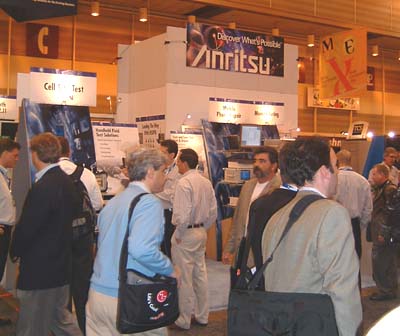
Anritsu announced its commitment to 3.5G High Speed Downlink Packet Access (HSDPA) technology at CTIA and backed it up by rolling out a number of new HSDPA test instruments during the event. Among them were the MD8480C, which Anritsu claims is the first HSDPA signaling tester and the only one that meets the full HSDPA specifications. The company also introduced the MG3700A, a vector signal generator that supports both 3.5G signals (including HSDPA) and even emerging 4G technologies. Additionally, Anritsu teamed with InterDigital Communications, demonstrating a solution that combined InterDigital's standards-compliant HSDPA coprocessor for mobile terminals with Anritsu's MD8480C signaling tester (acting as the base station).
For more information, visit Anritsu's storefront.
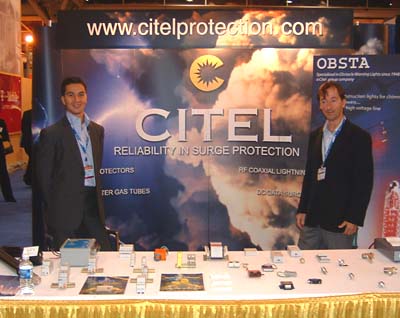
Surge protection specialist Citel, banking on the telecom rebound, exhibited a variety of devices at its booth, focusing primarily on AC and coaxial surge protection. Of note was the M Series of low-cost AC surge protectors aimed at wireless carriers (for shielding their cell cites) and tower maintenance companies. Citel also displayed their OBSTA line of obstacle warning lights, including the OBSTA STI, an ICAO (International Civil Aviation Organization) low-intensity type A warning light with a 15-year life expectancy.
For more information, visit www.citelprotection.com.
For obvious reasons, Freescale Semiconductor was excited about the FCC's decision to expand its ultra wideband (UWB) waiver -- which originally applied only to multiple orthogonal frequency division multiplexing (MB-OFDM) UWB technology (see related story) -- to also include the Freescale-supported direct sequence UWB (DS-UWB) technology. Freescale also announced a partnership with Marvell to provide wireless LAN (WLAN) solutions for mobile devices by combining Freescale's wireless platforms and applications processors with Marvell's IEEE 802.11 products.
For more information, visit www.freescale.com.
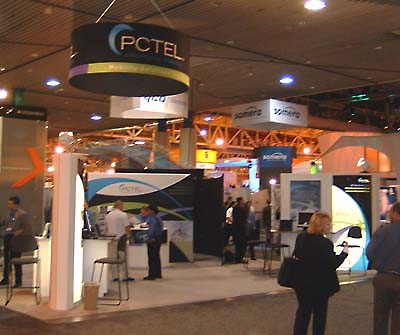
All three of PCTEL's divisions were represented at the company's booth. The Antenna Products Group unveiled the ASPDM913U, a new dual band elevated feed antenna designed to provide optimal coverage of both cellular and PCS frequencies with 3 dB of gain, and without a ground plane. The RF Solutions Group introduced its new SeeGull LX Dual-Mode Scanning Receivers, which provide simultaneous RF measurements for carriers migrating from 2.5G to 3G; the group also launched its CDMA CLARIFY Interference Measurement Solution for detecting and measuring interference in cellular networks. The Mobility Group showed its PCTEL Roaming Client, a software solution that enables wireless subscribers to roam among 802.11 Hot Spot networks without interruptions in service.
For more information, visit PCTEL Antenna Products Group's storefront.
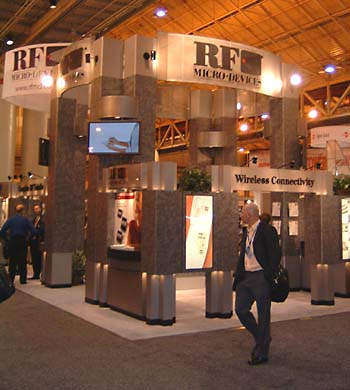
RF Micro Devices announced production shipments of the RF8900, which integrates Bluetooth communication, global positioning system (GPS) technology, and associated software into what the company is calling a "converged solution" for "puck-style" devices that transmit location information wirelessly. The company also launched a pair of new gallium arsenide heterojunction bipolar transistor (GaAs HBT) predriver power amplifiers (PAs) for cellular base station applications. The RF3807 and RF3809 operate across CDMA, GSM, DCS, PCS, and UMTS frequencies and lower the cost of implementation for base station manufacturers.
For more information, visit RF Micro Devices' storefront.
Royal Philips Electronics presented a new 802.11 WLAN semiconductor system-in-package (SiP) solution for mobile phones that reduces transmit (TX) and receive (RX) operating power consumption, while speeding consumer access to voice, data, and multimedia content through WLAN by up to 500%. Additionally, Philips announced a new complete Unlicensed Mobile Access (UMA) semiconductor reference design, which provides a blueprint for designing mobile phones that access GSM and GPRS mobile services through traditional cellular networks and automatically switch over to WLAN access points. Paul Marino, VP and general manager, Business Line Connectivity, Philips Semiconductors, informed me that Alcatel is currently conducting interoperability testing with the reference design.
For more information, visit www.semiconductors.philips.com.

A pair of new integrated RF transmit front end modules (FEMs) for CDMA, supporting both cellular and PCS frequencies, were Skyworks Solutions' significant new contribution to CTIA Wireless. The new SKY77408 and SKY77409 modules combine a host of Skyworks technologies -- power amplifier (PA), filter, input/output matching, power detector, and duplexer -- into a single 5 mm by 8 mm laminate package, shrinking board space by up to 40%. The FEMs employ Skyworks' proprietary Autosmart technology, which reduces the RF loss between the integrated components, resulting in improved talk time without external bias control.
For more information, visit Skyworks' storefront.
Summitek Instruments displayed its flagship product, SNAP (System for Network Analysis and Passive Intermodulation), at its CTIA booth. By connecting a vector network analyzer (VNA) to SNAP, manufacturers of passive components used in wireless networks can perform S-parameter and passive intermodulation (PIM) measurements with a single mouse click. Summitek also demonstrated the latest release of its OASIS spectrum monitoring and interference analysis software, which now boasts remote monitoring and multisite capabilities. Executive VP Rick Hartman explained to me that OASIS makes an analyzer "smart" by recording activity for future playback and evaluation.
For more information, visit Summitek's storefront.
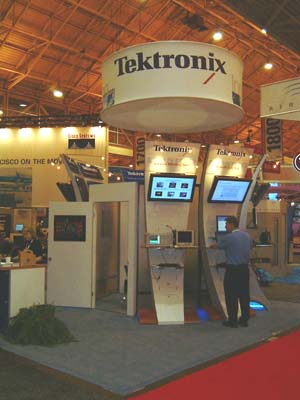
Keith Cobler, market development manager at Tektronix, talked to me about the state of the union in the wireless test and measurement (T&M) space. T&M companies, he said, are evolving from mere instrumentation suppliers to "strategic business partners" of both network operators and equipment manufacturers, supplying solutions that help companies increase their margins, reduce operating costs, and improve efficiency. Tektronix claims to be the only T&M vendor that factors into the complete lifecycle of voice, video, and data service delivery, providing products for the design, deployment, and optimization of wireless networks.
For more information, visit Tektronix' storefront.
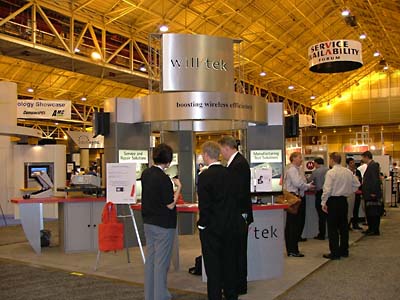
The new 4921 RF Shield from Willtek Communications, announced during CTIA, is a radio frequency (RF) shielding solution for use in the testing of wireless devices, such as 3G cellular phones, data cards, and WLAN equipment in large service centers and manufacturing lines. The Shield isolates the unit under test from adjacent units and other RF equipment. In addition, Willtek announced a partnership with Instrumentation Engineering (IE) , a provider of automatic test equipment (ATE) system integration and high-volume test system manufacturing solutions, to develop complete turnkey systems for mobile phone testing in the manufacturing environment.
For more information, visit www.willtek.com.
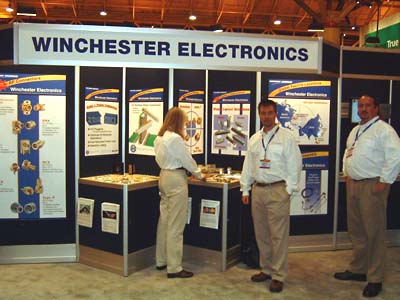
At its booth, connector supplier Winchester Electronics showcased its new PowerSnap line of snap-on style power connectors, which offer a more secure mating than typical slide-on power connectors. The connectors are available in SMT (surface mount technology), thru-hole, and cable versions and carry current up to 40 amps, depending on the configuration. Another new release for Winchester was a line of 50-amp High Density Plus female power modules, which supply a substantial increase in current-carrying capacity. The power modules are backward compatible with existing 4-row stiffeners, making them easy to incorporate into existing designs.
For more information, visit Winchester's storefront.
For more information on CTIA Wireless 2005, see "CTIA Wireless 2005 Adds Its Own 'Spice' To New Orleans" and "CTIA Wireless 2005 Photo Documentary".
